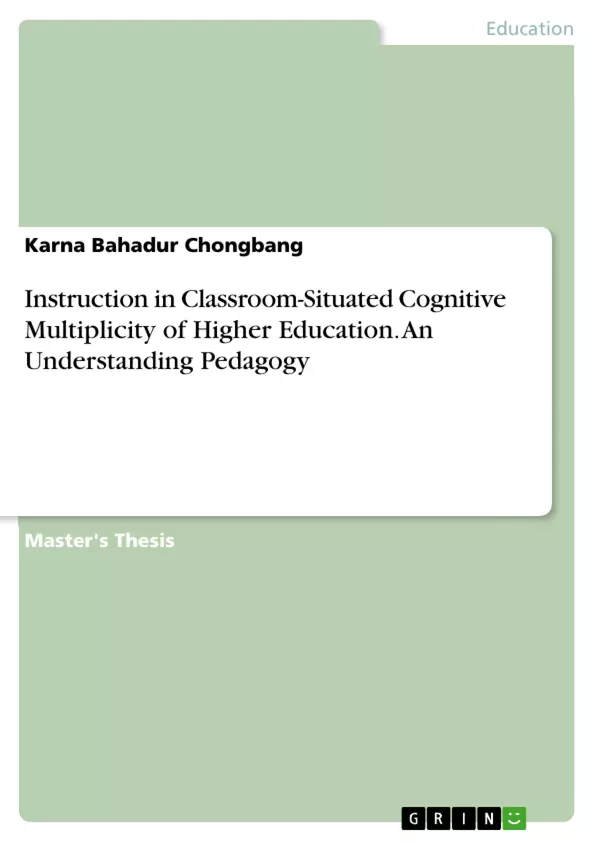This study intends to re-conceptualize a pedagogical approach to respond to students that are cognitively inactive in the classroom of higher education. The background of the thesis is set up on the ground of academic professional culture of pedagogical practice in the higher education. It has analyzed the intersecting positions of cognition and pedagogy.
Following a multi-paradigmatic approach to the thesis process, multidisciplinary theoretical perspectives have been used to interpret the cognitions situated in the classroom students. These perspectives allow to hold up a compatible research design, qualitative sounding and quantitative silence design and a non-positional position role of researcher. Analytic auto-ethnography was employed as a major method followed by other methods and tools like participant observation, interviews and group discussions, open- ended questionnaires and unobtrusive measures. Activating the meta-cognition of the research participants, the reflective understandings have been drawn from their individually situated cognition. The vignettes, student-composed texts and student and teacher-expressed opinions are the evidences and the data collected from the field. Crystallization of them by interfacing the theories reveals cognitive multiplicities (cognitive process, cognitive style, content schemata and thought system) in the students of higher education.
This paper looks for answers to several research questions: Why are the cognitions of every student not activated in the classroom? Have the present pedagogical practices activated every student's cognition in the classroom? Are the students in the classroom of higher education individually different in terms of cognition? Are there specific cognitive diversities in the students of the classroom? What are the current pedagogical practices in classrooms of higher education? What cognitive styles do the students possess in a classroom of higher education? How do the pedagogical practices of teachers/instructors respond the cognitive processes of the students? What is the pedagogical design/model to address the cognitive complexity/diversity of a classroom of higher education/teacher education?
Inhaltsverzeichnis (Table of Contents)
- Abstract
- Acknowledgements
- Chapter 1: Introduction
- 1.1: Background of the Study
- 1.2: Statement of the Problem
- 1.3: Objectives of the Study
- 1.4: Significance of the Study
- 1.5: Conceptual Framework
- 1.6: Definition of Key Terms
- 1.7: Organization of the Thesis
- Chapter 2: Review of Related Literature
- 2.1: Cognitive Multiplicity
- 2.1.1: Cognitive Process
- 2.1.2: Cognitive Style
- 2.1.3: Content Schemata
- 2.1.4: Thought System
- 2.2: Pedagogical Approaches
- 2.2.1: Traditional Pedagogy
- 2.2.2: Constructivist Pedagogy
- 2.2.3: Critical Pedagogy
- 2.3: Classroom Situated Cognition
- Chapter 3: Methodology
- 3.1: Research Design
- 3.2: Research Setting
- 3.3: Participants of the Study
- 3.4: Data Collection Procedures
- 3.4.1: Participant Observation
- 3.4.2: Interview and Group Discussion
- 3.4.3: Open-ended Questionnaire
- 3.4.4: Unobtrusive Measures
- 3.5: Data Analysis Procedures
- 3.6: Validity and Reliability
- 3.7: Ethical Considerations
- Chapter 4: Findings and Discussion
- 4.1: Cognitive Multiplicity in the Classroom
- 4.2: Current Pedagogical Practice and Cognitive Diversities
- 4.3: Pedagogical Transformation
- 4.4: Program for Higher Education Instruction
- 4.5: Critical Integrated Pedagogy
- Chapter 5: Conclusion and Implications
Zielsetzung und Themenschwerpunkte (Objectives and Key Themes)
This thesis aims to investigate the cognitive diversity in higher education classrooms and explore pedagogical approaches to address the needs of cognitively inactive students. It seeks to understand how cognitive processes, styles, schemata, and thought systems affect student engagement and learning in higher education.
- Cognitive Multiplicity in Higher Education
- The Impact of Pedagogical Practices on Cognitive Diversity
- The Need for Pedagogical Transformation in Higher Education
- The Development of a Program for Higher Education Instruction
- The Proposal of Critical Integrated Pedagogy as a Pedagogical Approach
Zusammenfassung der Kapitel (Chapter Summaries)
Chapter 1 introduces the background, problem statement, objectives, significance, conceptual framework, key terms, and organization of the thesis. It sets the stage for the study by outlining the context and rationale for the research.
Chapter 2 provides a comprehensive review of relevant literature on cognitive multiplicity, pedagogical approaches, and classroom situated cognition. It establishes the theoretical foundations for the study and informs the research design.
Chapter 3 outlines the research methodology, including the research design, setting, participants, data collection procedures, data analysis, validity and reliability, and ethical considerations. It provides a detailed account of how the study was conducted.
Chapter 4 presents the findings of the study, which are derived from the data analysis. It discusses the implications of the findings and their relevance to the research questions and objectives.
Schlüsselwörter (Keywords)
The key keywords and focus topics of this thesis include: cognitive multiplicity, pedagogy, higher education, classroom situated cognition, pedagogical transformation, critical integrated pedagogy, cognitive diversity, student engagement, and learning.
- Quote paper
- Karna Bahadur Chongbang (Author), 2016, Instruction in Classroom-Situated Cognitive Multiplicity of Higher Education. An Understanding Pedagogy, Munich, GRIN Verlag, https://www.grin.com/document/376612



